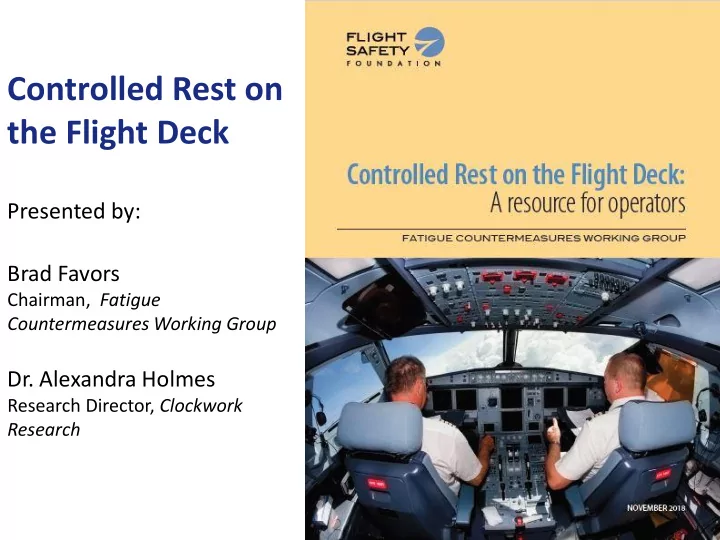

Controlled Rest on the Flight Deck Presented by: Brad Favors Chairman, Fatigue Countermeasures Working Group Dr. Alexandra Holmes Research Director, Clockwork Research
About the Fatigue Countermeasures Working Group The Fatigue Countermeasures Working Group is comprised of: • Fatigue Safety Managers from multiple commercial air transport operators • Labor representatives from multiple pilot unions • Researchers and scientists from Clockwork Research, NASA Ames Research Center, and Washington State University • Various independent fatigue and human performance research organizations “…Improving operational safety by providing proven performance-enhancing strategies for managing fatigue risk in aviation.”
Why offer the resource guide? • Fatigue risk management via flight time/duty time limitations alone may not be effective • Operators who do not have a CR procedure may be lacking a very valuable tool in their fatigue management toolkit • Operators who do have a CR procedure may not be fully appreciating the benefits available from CR • Fatigue risk within an operation may be masked by the use of controlled rest when CR is not tracked • CR may introduce unintended consequences in the form on sleep inertia when not properly mitigated
What is included in the resource document? • Provide the first overview of the practice of CR • Provide an up-to-date overview of the scientific research on napping, sleep inertia, and CR • Assist operators new to CR in deciding whether to introduce a CR procedure • Assist operators in documenting and implementing an effective CR procedure • Assist operators with an existing CR procedure in reviewing and improving the procedure • Provide guidance on how to monitor and continuously improve CR as part of an FRM program
Designing an effective CR procedure
Reports of the use of CR to enable FRM • At 2 airlines, up to 30% of all fatigue reports cite the use of CR as a fatigue countermeasure • 53% of pilots (n=253) operating regional and international flights used CR in the prior 12 months (Petrie et al., 2004) • Case study: 20% of crew took CR on a long-haul daytime flight, which contributed to a decision to add an additional pilot
Conclusion A formal CR policy and a supporting relevant procedure describing how to undertake CR are necessary to harness the benefits of napping while limiting the potential for uncontrolled microsleeps and napping. Considering: • the strength of the science demonstrating the benefits of naps to manage fatigue • the common occurrence of uncontrolled or unintentional sleep where CR is not allowed • positive feedback on CR from operators who are already experienced CR should be considered a beneficial tool to help manage unanticipated fatigue.
Questions? Brad Favors Manager Fatigue & Human Performance Southwest Airlines Brad.Favors@wnco.com Dr. Alexandra Holmes Research Director Clockwork Research Alex.Holmes@clockworkresearch.com
Recommend
More recommend